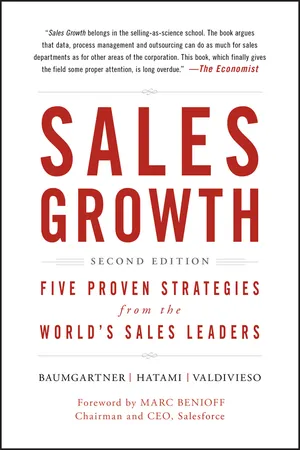
Sales Growth
Five Proven Strategies from the World's Sales Leaders
- English
- ePUB (mobile friendly)
- Available on iOS & Android
Sales Growth
Five Proven Strategies from the World's Sales Leaders
About this book
The challenges facing today's sales executives and their organizations continue to grow, but so do the expectations that they will find ways to overcome them and drive consistent sales growth.
There are no simple solutions to this situation, but in this thoroughly updated Second Edition of Sales Growth, experts from McKinsey & Company build on their practical blueprint for achieving this goal and explore what world-class sales executives are doing right now to find growth and capture it—as well as how they are creating the capabilities to keep growing in the future.
Based on discussions with more than 200 of today's most successful global sales leaders from a wide array of organizations and industries, Sales Growth puts the experiences of these professionals in perspective and offers real-life examples of how they've overcome the challenges encountered in the quest for growth.
The book, broken down into five overarching strategies for successful sales growth, shares valuable lessons on everything from how to beat the competition by looking forward, to turning deep insights into simple messages for the front line. Page by page, you'll learn how sales executives are digging deeper than ever to find untapped growth, maximizing emerging markets opportunities, and powering growth through digital sales. You'll also discover what it takes to find big growth in big data, develop the right "sales DNA" in your organization, and improve channel performance. Three new chapters look at why presales deserve more attention, how to get the most out of marketing, and how technology and outsourcing could entirely reshape the sales function.
Twenty new standalone interviews have been added to those from the first edition, so there are now in-depth insights from sales leaders at Adidas, Alcoa, Allianz, American Express, BMW, Cargill, Caterpillar, Cisco, Coca-Cola Enterprises, Deutsche Bank, EMC, Essent, Google, Grainger, Hewlett Packard Enterprise, Intesa Sanpaolo, Itaú Unibanco, Lattice Engines, Mars, Merck, Nissan, P&G, Pioneer Hi-Bred, Salesforce, Samsung, Schneider Electric, Siemens, SWIFT, UPS, VimpelCom, Vodafone, and Würth. Their stories, as well as numerous case studies, touch on some of the most essential elements of sales, from adapting channels to meet changing customer needs to optimizing sales operations and technology, developing sales talent and capabilities, and effectively leading the way to sales growth.
Engaging and informative, this timely book details proven approaches to tangible top-line growth and an improved bottom line. Created specifically for sales executives, it will put you in a better position to drive sales growth in today's competitive market.
Frequently asked questions
- Essential is ideal for learners and professionals who enjoy exploring a wide range of subjects. Access the Essential Library with 800,000+ trusted titles and best-sellers across business, personal growth, and the humanities. Includes unlimited reading time and Standard Read Aloud voice.
- Complete: Perfect for advanced learners and researchers needing full, unrestricted access. Unlock 1.4M+ books across hundreds of subjects, including academic and specialized titles. The Complete Plan also includes advanced features like Premium Read Aloud and Research Assistant.
Please note we cannot support devices running on iOS 13 and Android 7 or earlier. Learn more about using the app.
Information
Strategy 1
Find Growth Before Your Competitors Do
Chapter 1
Look Ten Quarters Ahead
For tomorrow belongs to the people who prepare for it today.—African proverb
- Surf the trends. Good sales leaders know how to hit monthly and annual sales targets. Great sales leaders tap into the big picture, watching for strategic openings in economic trends or changes in customer sectors and regions. They know these can be real opportunities.
- Invest ahead of demand. This might mean making a small investment in analytic capabilities or beefing up the number of frontline sales staff ahead of the emerging trend.
- Make it a way of life. Programs that successfully exploit emerging trends are not one-off flukes or lucky bets. Leading sales organizations have a built-in forward perspective and mechanisms to turn insights into action.
Surf the Trends
| Example trend | Opportunities | |
| Technological | Internet of Things: estimated economic impact is $3.9 trillion – $11.9 trillion by 2025. | Use IoT data and advanced analytics to generate sales insights. |
| Political | Cybersecurity: The US government has set a $16 billion budget for cybersecurity in 2016; the budget has been growing at an annual rate of 24%. | Offer products and services with increased security, and emphasize these features in value propositions. |
| Geographical | Emerging markets: Expected to expand by an average of 4.7% annually from 2012–25. | Invest sales resources in growing markets to establish incumbent position. |
| Regulatory | Carbon emission reductions: e.g., EU targeting 40% reduction by 2030. | Go after customers most affected by regulatory changes. |
Invest Ahead of Demand
Table of contents
- Cover
- Praise
- Title page
- Copyright
- Foreword
- Preface
- Strategy 1 Find Growth Before Your Competitors Do
- Strategy 2 Sell the Way Your Customers Want
- Strategy 3 Supercharge Your Sales Engine
- Strategy 4 Focus on Your People
- Strategy 5 Lead Sales Growth
- Epilogue Reimagine Sales Growth
- About the Authors
- Acknowledgments
- Index
- EULA